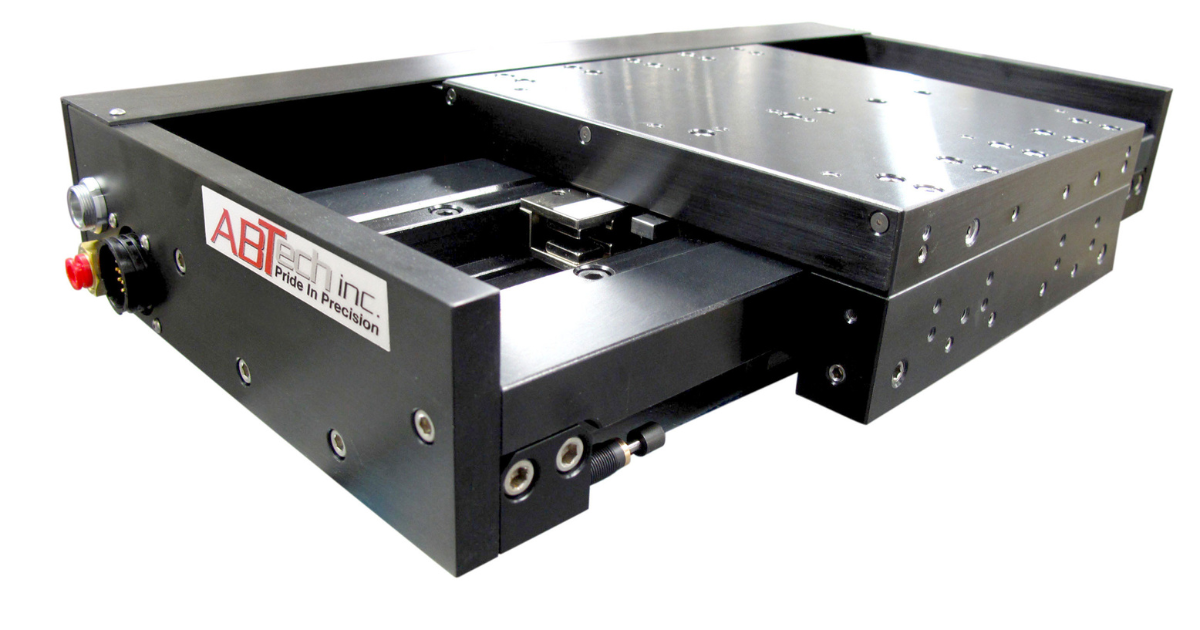
ABTech produces a wide range of precision motion machines for three major product categories: air bearing rotary tables, air bearing stages, and air bearing spindles.
In addition to customized air bearing devices, ABTech also designs and manufactures hydrostatic and mechanical bearing machines in its American owned and operated facility in Fitzwilliam, NH.
For industries that demand smooth linear motion, air bearings are indispensable—using a thin film of pressurized air, they can achieve sub-micron accuracies at high speed, again and again, with near-infinite repeatability.
Fundamentally, air-bearing stages do two things exceptionally well:
- Positioning
- Scanning/inspection
Air bearing stages (also known as linear slides or linear stages) have numerous applications. Semiconductor manufacturers, for example, use them for precise positioning during laser cutting and constant, smooth movement during wafer inspection.
While selecting a stage from a supplier’s catalog is possible, getting an “off-the-shelf” machine that fits your application can be challenging. At ABTech, our customer-centric approach to designing custom air-bearing stages considers a stage’s performance requirements and operational needs, as well as the customer’s physical plant or factory environment.
Let’s review a few custom considerations for air bearing stages.
Air Bearing Stage Performance
In contrast to oil hydrostatic or mechanical bearing stages, “air bearings provide a level of accuracy that other slides don’t,” says Chris Abbott, COO of ABTech. Air bearing stages can deliver sub-micron accuracy, and the specifics depend on each end-use application. Establishing the final performance requirements is one of the top priorities during design.
Learn more at Intro to Linear Stages: From the Basics to Design Factors
Speed Performance
At ABTech, we factor in speed, acceleration, and deceleration requirements. With air bearings, it’s possible to make very small, quick movements with little to no effects from static friction because of the non-contact movement.
Accuracy Performance
Frictionless operation allows air bearings to position a component to an impressive 0.025 microns, or one millionth (0.000001) of an inch, conditional to the customer’s needs. A key part of this is being able to fabricate a perfectly straight rail; any straightness error affects a stage’s final accuracy.
Control Systems
While it’s not mandatory to specify a control system for an air bearing stage, depending on the performance requirements, a particular control system may be necessary for all components to work harmoniously.
- Linear encoders
- Servo controllers
- Motion planning algorithms
- More
A high-performance brushless DC servo motor is ABTech’s “go-to” for most air bearing control systems. Through experience, ABTech has found this type of unit doesn’t interfere with sub-micron accuracies or cause print-through on parts.
Component Handling
Knowing that an air bearing stage can check the boxes for accuracy and speed is good, but it’s not enough. The stage also needs to physically move a component to where it’s required.
Weight Capacity
A functional air bearing stage must carry the total weight of a customer’s part. ABTech finds it valuable to design for weight and, if the part is heavy enough, its center of gravity. Since an air bearing stage may be part of an assembly system, there could be additional weight to consider (such as a rotary table). It’s important to include all components in capacity evaluations.
Orientation of Motion
An air bearing stage can operate in the horizontal or vertical orientation, or as part of a multi-axis assembly. Horizontal designs (along the X and/or Y axis) are relatively simple compared to vertical, Z-axis movement. For vertical positioning, ABTech addresses the slide having to lift the weight of the carriage itself by using a counterbalance to minimize the required motor size.
See ABTech’s 3-Step Custom Approach to Air Bearing Desing
Size, Location, and Environment
It’s not unusual for an air bearing stage to be part of a larger manufacturing application. ABTech’s designs consider the available space along with features to address environmental factors that could introduce performance errors.
Available Footprint
Of course, an air bearing stage needs to be able to fit into a plant, factory, or assembly. Often, space requirements are fixed (and possibly confined, requiring a compact design). If space is abundant, however, it’s still wise to consider where metrology staff will access the machine or where an operator can stand for manual operation.
Environmental Factors
Temperature, vibration, cleanliness, and humidity affect an air bearing stage’s performance, particularly at the sub-micron level. Even something that seems harmless, like traffic outside a plant, has the potential to affect performance. A knowledgeable precision motion builder understands these non intuitive issues and how to avoid them.
The Artistry Behind Linear Precision Motion
ABTech crafts extraordinary devices, one design at a time—right from the outset, ABTech’s air bearing stages are built around a client’s goals and objectives.
“The linear portion of our business is just so application-specific,” says Abbott, “and there are certainly catalog companies out there that have a dozen different sizes and you pick from those, but there’s really so much need for custom. What sets us apart is that we have this desire to start from a blank sheet on every new application.”
ABTech looks forward to supporting your next project.
Contact ABTech today!








